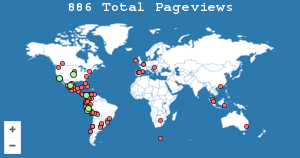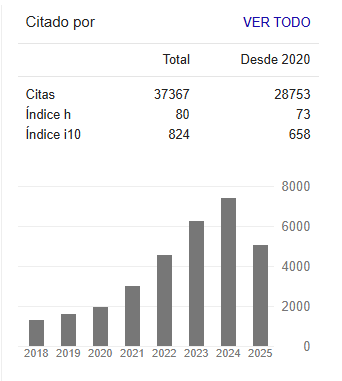Disaster risk management within the framework of a preventive culture
Abstract
Facing the environmental problem that the planet is experiencing is one of the greatest challenges in guaranteeing the permanence of the human being, as expressed in the United Nations Scientific Conference, also known as the First Earth Summit; strategically planned and applied risk management paves the way to obtain a competitive advantage and a decisive advantage for public organizations. The objective of the research was to analyze disaster risk management in the macro of preventive culture from the lived experiences of workers in a public hospital in Lima. The present study is framed in the interpretive paradigm under a qualitative approach, as for the research design, Hernández & Mendoza (2018) frame it within the interpretative phenomenological design when describing, exploring, but above all when understanding the context in which it is develops the investigation due to the flexibility of the process that is adapted to each reality, the analysis unit was 10 collaborators of the hospital brigade. The results indicate that the preventive culture has a positive impact on public hospital workers; impacting prevention positively not only in limiting the severity of the damage caused by the disaster, but also in the recovery capacity that the hospital will have once the event has occurred. Hospital employees do not know how to act in the face of a natural disaster due to the lack of training on risk prevention measures to improve response capacities to adverse events.
References
Ayala, R. (2008). La metodología fenomenológico-hermenéutica de M. Van Manen en el campo de la investigación educativa. Posibilidades y primeras experiencias. Revista de Investigación Educativa, 26(2), 409-430. https://revistas.um.es/rie/article/view/94001
Bozaykut-Bük, T. (2017). Giving Risk Management Culture a Role in Strategic Planning. En H. Dinçer, & Ü. Hacioğlu (Edits.), Risk Management, Strategic Thinking and Leadership in the Financial Services Industry (págs. 311-321). Estambul: Springer. https://doi.org/10.1007/978-3-319-47172-3_21
Calderón, D. R., & Frey, K. (2017). El ordenamiento territorial para la gestión del riesgo de desastres en Colombia. Territorios, (36), 239-264. http://dx.doi.org/10.12804/revistas.urosario.edu.co/territorios/a.4795
Cardone, V. (2017). Estudio sobre la gestión del riesgo en desastres ambientales naturales. https://bit.ly/2QRHzBW
Comisión Nacional de Prevención de Riesgos y Atención de Emergencias. (2014). Normas y elementos básicos de gestión municipal del riesgo de desastre con énfasis en prevención, control y regulación territorial. San José, Costa Rica: La Comisión, Sistemas Geoespaciales. https://bit.ly/3tO2V1C
Elahi, E. (2013). Risk management: the next source of competitive advantage. Foresight, 15(2), 117-131. https://doi.org/10.1108/14636681311321121
Giannakis, M., & Papadopoulos, T. (enero de 2016). Supply chain sustainability: A risk management approach. International Journal of Production Economics, 171(4), 455-470. https://doi.org/10.1016/j.ijpe.2015.06.032
Hernández, R., & Mendoza, C. (2018). Metodología de la investigación: las rutas cuantitativa, cualitativa y mixta. McGraw-Hill Education.
Instituto Nacional de Defensa Civil del Perú. (2010). Atlas de peligros del Perú 2010. Lima: Indeci.
Méndez, E., Figueredo, C., Chirnios, E., Goyo, A., & Rivero, E. (2011). Cultura preventiva del riesgo laboral del docente universitario. Revista Multiciencias, 44-49. https://www.redalyc.org/pdf/904/90418851006.pdf
Morejón, A. (1 de octubre de 2006). Formación de la conciencia ambiental, importancia de la ética ambiental y la educación ambiental en este proceso. https://bit.ly/3dMirFu
Narváez, L., Lavell, A., & Pérez Ortega, G. (2009). La gestión del riesgo de desastres: un enfoque basado en procesos. Lima: Secretaría General de la Comunidad Andina.
Ocampo, M., y Santa Catarina, C. (2019). Gestión del Riesgo de Desastres. INCYTU, (33), 1-6.
Ochoa Henríquez, O. J., & Hidalgo López, C. R. (2016). Caracterización de la cultura ambiental en la gestión de la Universidad Centroccidental Lisandro Alvarado. Compendium, 19(37), 27-53. https://www.redalyc.org/pdf/880/88049677003.pdf
Pastrana, J., Potenciano de la Heras, Á., & Gavari, E. (2019). Gestión de riesgo de desastres y protección civil en España: aportes para el desarrollo de una cultura preventiva. Revista de Estudios Latinoamericanos sobre Reducción del Riesgo de Desastres Reder, 3, 44-57. http://revistareder.com/ojs/index.php/reder/article/view/31/33
Polo, J. C. (octubre-diciembre de 2013). El Estado y la educación Ambiental Comunitaria en el Perú. Acta Médica Peruana, 30(4), 141-147. http://www.scielo.org.pe/pdf/amp/v30n4/a17v30n4.pdf
Pulido, V., & Olivera, E. (2018). Aportes pedagógicos a la educación ambiental: una perspectiva teórica. Revista de Investigaciones Altoandinas, 20(3), 333-346. http://dx.doi.org/10.18271/ria.2018.397
Sánchez, H. y Reyes C. (2015). Metodología y Diseños en la Investigación Científica. Editorial Business Support Aneth S.R.L
Sandoval Díaz, J. S., Rojas Páez, L., Villalobos Soublet, M., Sandoval Díaz, C., Moraga R., F., & Aguirre P., N. (mayo de 2018). De organización vecinal hacia la gestión local del riesgo: diagnóstico de vulnerabilidad y capacidad. Revista INVI, 33(92), 155-180. http://dx.doi.org/10.4067/S0718-83582018000100155
Secretaría Nacional de Gestión de Riesgos. (2012). Manual del Comité de Gestión de Riesgos. https://reliefweb.int/sites/reliefweb.int/files/resources/Informe_completo_20.pdf
Van der Merwe, P. (2020) Prevention and preparedness: biosecurity, early warning and contingency planning. Rev. Sci. Tech. Off. Int. Epiz., 39 (2), 551-559 http://dx.doi:10.20506/rst.39.2.3106
Velásquez, A. (julio-septiembre de 2016). Salud en el Perú: hacia la cobertura universal y una respuesta efectiva frente a riesgos sanitarios. Revista Peruana de Medicina Experimental y Salud Publica, 33(3), 397-398. http://dx.doi.org/10.17843/rpmesp.2016.333.2339








.png)






























